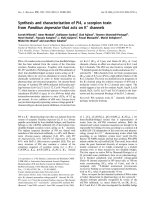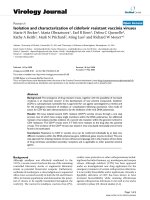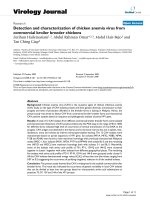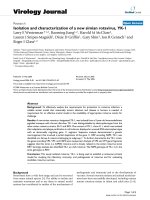Báo cáo hóa học: " Synthesis and Characterization of Metal Nanoparticle Embedded Conducting Polymer–Polyoxometalate Composites" doc
Bạn đang xem bản rút gọn của tài liệu. Xem và tải ngay bản đầy đủ của tài liệu tại đây (491.69 KB, 7 trang )
NANO EXPRESS
Synthesis and Characterization of Metal Nanoparticle Embedded
Conducting Polymer–Polyoxometalate Composites
Pilli Satyananda Kishore Æ Balasubramanian Viswanathan Æ
Thirukkallam Kanthadai Varadarajan
Received: 20 August 2007 / Accepted: 20 November 2007 / Published online: 13 December 2007
Ó to the authors 2007
Abstract Phosphomolybdate has been employed simul-
taneously as the oxidizing agent for the monomer
polymerization and the reduced polyoxometalate is used as
reducing agent for the reduction of metal ions. The com-
posites thus obtained have been characterized and may
have many potential applications.
Keywords Conducting polymer Á Polyoxometalates Á
Organic–inorganic hybrid nanocomposites Á Silver Á
Gold
Introduction
The desire to synthesize nanostructures that combine the
mechanical flexibility, optical and electrical properties of
conducting polymers with the high electrical conductivity
and magnetic properties of metal nanaoparticles has
inspired the development of several techniques for the
controlled fabrication of metal nanoparticle—conducting
polymer composites. The incorporation of metal nanopar-
ticles into the conducting polymer offers enhanced
performance for both the host and the guest [1]. They have
diverse application potentials in electronics because
incorporation of metal clusters is known to increase the
conductivity of the polymer [2]. The applications of these
composites have also been extended to various fields such
as, sensors [3, 4], photovoltaic cells [5], memory devices
[6], protective coatings against corrosion [7], and sup-
ercapacitors [8]. Of particular interest is the application of
these composites in catalysis. The polymer allows the
control of the environment around the metal center, thus
influencing selectivity of the chemical reactions. Polyani-
line (PAni) supported Pd nanoparticles have been used for
the oxidative coupling of the 2,6-di-t-butylphenol [9]. In
terms of engineering applications, conducting polymer-
supported metal nanoparticle catalysts are attractive
materials for fuel cell design. For example, direct alcohol
and proton exchange membrane fuel cell electrocatalysts
based on conducting polymers have been studied [10–12].
Dispersing the metal nanoparticles into a conducting
polymer matrix maintains the electrical connectivity of the
particles to the underlying electrode [13, 14]. Under opti-
mal conditions, this arrangement may result in enhanced
electrocatalytic properties compared to the corresponding
reactivity of the bulk metal [15]. Various methods for the
preparation of nanoparticle embedded conducting polymer
composites have been described, including template
method for growing metal nanoparticles and polymers into
nanostructures [16], photochemical preparation [17], and
electrochemical methods involving, incorporation of metal
nanoparticles during the electrosynthesis of the polymer
[18] or electrodeposition of metal nanoparticles on pre-
formed polymer electrodes [19], reduction of metal salts
dissolved in a polymer matrix [20], and incorporation of
preformed nanoparticles during polymerization of mono-
mers [21] or nanoparticles generated during polymerization
[22, 23
]. Creation of ideal reaction conditions for the
simultaneous reactions (polymerization and nanoparticle
formation) is a challenge. The synthesis of nanoparticle and
polymer using the same reagent in aqueous solution for
generating nanoparticles and polymer in the form of a
composite is particularly important, as it reduces the
P. S. Kishore Á B. Viswanathan (&) Á T. K. Varadarajan
National Centre for Catalysis Research, Department
of Chemistry, Indian Institute of Technology Madras,
Chennai 600036, India
e-mail:
123
Nanoscale Res Lett (2008) 3:14–20
DOI 10.1007/s11671-007-9107-z
number of steps in a complex set of sequential reactions to
the formation of a composite.
Polyoxometalates are well-defined metal-oxide polyan-
ions that can undergo stepwise and multi-electron reactions
while retaining structural integrity [24]. The introduction of
polyoxometalates into conducting polymer network can be
conveniently accomplished by taking advantage of the
doping process of polymer leading to incorporation of
charge-balancing species into the structure [25]. The strong
oxidizing potential and acidic character of Keggin type
polyoxometalate, Phosphomolybdic acid (H
3
PMo
12
O
40
,
PMo
12
) provides perfect environment for the polymeriza-
tion of monomers such as aniline, pyrrole, or thiophene to
yield corresponding polymer–polyoxometalate composites.
Different conducting polymers–polyoxometalate compo-
sites have been prepared by both chemical and
electrochemical routes and used for photoelectrochemical
and energy storage applications [26–29], but as such, there
are no reports available on the incorporation of metal
nanoparticles on the PAni-PMo
12
composites by using a
single reagent.
The present investigation focuses on the synthesis of
Au or Ag nanoparticles embedded PAni-PMo
12
com-
posites (Ag-PAni-PMo
12
and Au-PAni-PMo
12
)and
characterization of the formed composites. The PMo
12
as
reagent for simultaneous oxidation of aniline and
reduction of metal salts for the synthesis of nanocom-
posites has not been reported so far. During the oxidation
of aniline, PMo
12
get reduced to heteropoly blue which
then serve as reducing agent for the metal (Ag and Au)
ions to form metal nanoparticles. The high-resolution
transmission electron microscopic analysis revealed for-
mation of metal embedded polymer nanostructures. The
present method can also be extended for the preparation
of various metal nanoparticles containing nanocompos-
ites with different conducting polymers such as
polypyrrole and poly(3,4-dioxy thiophene). Further, the
properties of the inorganic–organic composites can be
tailored by simply varying the polymer or polyoxomet-
alate which are desired for electrocatalytic and sensor
applications.
Experimental
Materials
Aniline from Aldrich was distilled under vacuum prior to
use. Phophomolybdic acid (H
3
PMo
12
O
40
, PMo
12
) was
procured from Aldrich and used further without purifica-
tion. AgNO
3
and HAuCl
4
were obtained from Sisco
research laboratories and used as received. Ultrasonic
treatment of the composites was performed on TOSHCON
sonicator (20 KHz, 100 W), India.
Preparation of Metal Nanoparticles Embedded
PAni-PMo
12
Composite
In a typical experiment, an aqueous solution of PMo
12
(50 mM, 600 lL) was added to aniline monomer (100 lL)
and this led to the reduction of PMo
12
and oxidative poly-
merization of aniline. The appearance of an intense blue color
due to the formation of polyoxomolybdate blue indicated the
electron transfer from aniline to PMo
12
. To this solution,
10 mM aqueous solution of AgNO
3
was added and ultraso-
nicated for 5 min. This was then allowed to stand for 24 h.
Theaspreparedsample(Ag-PAni-PMo
12
)wasfilteredout,
washed, and dried under vacuum. Similar strategy was
adopted for the preparation of Au nanoparticles by using
10 mM HAuCl
4
to prepare Au-PAni-PMo
12
composite.
Structural Characterization
UV–Visible spectra were recorded on Cary 5E UV–Vis-
NIR spectrometer. FTIR investigations were performed on
Perkin–Elmer 1760 in the region 2,000–400 cm
-1
with 32
scans by using KBr pellet mode. Powder X-ray diffraction
patterns were recorded using a SHIMADZU XD-D1 dif-
fractometer using a Ni-filtered Cu Ka radiation
(k = 1.5418 A
˚
at a 0.2° scan rate (in 2h). The morphology
of the composites was investigated by a scanning electron
microscopy (SEM) (FEI, Model: Quanta 200). The trans-
mission electron micrograph (TEM) analysis was
performed on CM12/STEM working at a 100 kV acceler-
ating voltage. High-resolution transmission electron
microscopy (HRTEM) was carried out on a JEOL-3010
instrument operating at 300 kV. Textural characteristics of
composites were determined from nitrogen adsorption/
desorption at 77 K using a Micrometrics ASAP 2020
instrument. The specific surface area, average pore diam-
eters were determined. Prior to the measurements, the
samples were degassed at 423 K. The BET specific surface
area was calculated by using the standard Brunauer,
Emmett, and Teller method on the basis of the adsorption
data. The pore size distributions were calculated applying
the Barrett–Joyner–Halenda (BJH) method. For conduc-
tivity measurements the composites were pressed in a
manual hydraulic press at 750 MPa into a pellet of 13-mm
diameter and 0.56-mm thickness. The conductivity mea-
surements of Au-PAni-PMo
12
and Ag-PAni-PMo
12
were
measured by the four-point Van der Pauw method [30].
The experimental setup included a Keithley 225 current
source and Agilent 34401 voltmeter.
Nanoscale Res Lett (2008) 3:14–20 15
123
Results and Discussion
Polyoxometalates can be reduced in a plethora of ways, for
example photochemically [31], through
60
Co-c radiolysis
[32], electrolytically [33], and with reductants [34]. The
reduced polyoxometalate has served as reducing agent and
stabilizing agent for the formation of various metal nano-
particle–polyoxometalate composites [35]. Gordeev et al.
have noticed the ability of radiolytically two-electron
reduced 12-tungstophosphate, [PW
12
O
40
]
5-
, to reduce Ag
ions into stable silver hydrosols [36]. The synthesis of
metal nanoparticle–polyoxometalate composites based
photo-catalytic reduction has been pioneered by Papacon-
stantinou et al. [31]. Wherein, polyoxometalates
(SiW
12
O
40
4-
,PW
12
O
40
3-
) have served as photocatalysts and
stabilizing agents for the formation of metal nanoparticles.
Recently, Mandal et al. developed the synthesis of Au–Pd
core shell nanoparticles using redox switching ability
of Keggin ions [37]. In the present work, the formation of
reduced PMo
12
was observed during the polymerization of
aniline in the presence of PMo
12
. The reduced PMo
12
species served as reducing agent for the reduction of metal
ions to form metal nanoparticle embedded PAni-PMo
12
composite. The different stages of synthesis of the com-
posites (Steps I and II, Scheme 1) were monitored by UV–
Vis spectra (Fig. 1). Figure 1a corresponds to the UV–Vis
spectrum recorded from PMo
12
solution which has no
obvious absorbance in the range 400–800 nm. Figure 1b
corresponds to the UV–Vis absorption of the blue-colored
solution containing PMo
12
and aniline (Step I, Scheme 1);
the presence of an absorption band at 700 nm can be seen
and is characteristic of one-electron reduced PMo
12
(elec-
tron is transferred from aniline to PMo
12
). The produced d
1
metal ion [38] of Mo is responsible for the d–d transition
resulting in absorption in the visible region. Figure 1c, d
correspond to the spectra of PMo
12
-PAni solution to
which AgNO
3
and HAuCl
4
solutions were added respec-
tively (Step II, Scheme 1); strong absorption bands at 450
and 573 nm due to the excitation of surface plasmon
resonance of Ag and Au nanoparticle in Ag-PAni-PMo
12
(Fig. 1c) and Au-PAni-PMo
12
(Fig. 1d), respectively, were
observed.
The presence of Ag and Au nanoparticles in Ag-PAni-
PMo
12
and Au-PAni-PMo
12
was further confirmed by
powder XRD measurements, as shown in Fig. 2. The XRD
pattern of Ag nanoparticles containing composite showed
four strong peaks with maximum intensity at 38.1°, 44.3°,
64.4°, and 77.4° representing Bragg’s reflections from
(111), (200), (220), and (311) planes of the standard cubic
phase of Ag (Fig. 2a). Au-PAni-PMo
12
composite also
exhibited the presence of four strong peaks with maximum
intensity at 38.2°,44.4°, 64.5°, and 77.5° representing
(111), (200), (220), and (311) planes of standard cubic
phase of Au (Fig. 2b).
Scheme 1 Schematic representation of the PMo
12
-mediated synthe-
sis of metal nanoparticle embedded PAni-PMo
12
composites
Fig. 1 UV–Vis spectra of (a) 10 mM PMo
12
(b) a mixture of 5 mM
PMo
12
and 20 lL of aniline (c) after addition of 10 mM AgNO
3
(d)
after addition of 10 mM HAuCl
4
Fig. 2 XRD patterns of (a) Ag-PAni-PMo
12
and (b) Au-PAni-PMo
12
16 Nanoscale Res Lett (2008) 3:14–20
123
In order to confirm the presence of PAni and the phos-
phomolybdate anion in the composites, Fourier transform
infrared (FTIR) analysis of the Ag-PAni-PMo
12
and Au-
PAni-PMo
12
(Fig. 3a, b) nanocomposites was carried out.
Both the composites showed the characteristic bands of
PAni (marked with arrows) and phosphomolydate anion
(marked with circles). The peak at 1,575 cm
-1
is assigned
to a deformation mode of benzene rings, the one at
1,488 cm
-1
to a deformation of benzene or quinoide rings,
the one at 1,248 and 1,147 cm
-1
to a C=N stretching of a
secondary amine, at 1,060 cm
-1
to a P–O bond, at
955 cm
-1
to a Mo=O terminal bond, at 876 cm
-1
to a
vertex Mo–O–Mo bond, and finally at 800 cm
-1
to an edge
Mo–O–Mo bond.
The nitrogen adsorption/desorption isotherms of Ag-
PAni-PMo
12
and Au-PAni-PMo
12
composites are shown in
Fig. 4a, b respectively. The isotherms were identified as
type IV isotherms with H3 type Hysteresis loops. The pore
size distributions were calculated and represented in the insets
of Fig. 4a, b. Both the composites exhibited a broad distri-
bution of mesopores ranging from 2 nm to 43 nm. The
average pore sizes were determined and found to be 23.8 nm
for Au-PAni-PMo
12
and 22.4 nm for Ag-PAni-PMo
12
.
The BET surface areas were also found to be similar, 7 and
6m
2
/g for Ag-PAni-PMo
12
and Au-PAni-PMo
12
composites
respectively.
The morphology of the prepared nanocomposites was
examined using scanning electron microscopy (SEM).
Figure 5a, b shows the SEM images of Ag-PAni-PMo
12
and Au-PAni-PMo
12
composites, respectively. The nano-
composites exhibited a highly mesoporous structure which
is of great interest for their application as electrodes since it
represents an optimization of the electrode–electrolyte
interface.
Figure 6a, b shows typical low-magnification TEM
images of the Ag-PAni-PMo
12
composites. The spherical
Ag nanoparticles are well distributed and stabilized by the
polymer. The corresponding histogram (Fig. 7a) of the size
distribution of the Ag nanoparticles indicates a broad dis-
tribution ranging from 3.5 nm to 9 nm of the Ag
nanoparticles formed during the reaction. TEM images of
Au-PAni-PMo
12
composite (Fig. 6c, d) show most of the
Au nanoparticles aggregated with a size distribution rang-
ing from 4 nm to 9 nm (Fig. 7b). The particles are
aggregated into dendritic structures composed of nanorod
arms with an average diameter of ca 3 nm and length
10 nm and they were rather polydisperse. The detailed
structure of the Ag and Au nanoparticles in the prepared
nanocomposites was further revealed by high-resolution
TEM (Fig. 8). From Fig. 8a, it can be seen that the
spherical silver nanoparticles embedded in PAni polymer
in the Ag-PAni-PMo
12
composite and nanoparticles have
Fig. 3 FTIR spectra of (a) Ag-PAni-PMo
12
and (b) Au-PAni-PMo
12
Fig. 4 N
2
adsorption/desorption isotherms of (a) Ag-PAni-PMo
12
and (b) Au-PAni-PMo
12
(inset: the BJH pore size distribution)
Nanoscale Res Lett (2008) 3:14–20 17
123
clear crystalline planes aligned along a specific direction
with a d spacing of 2.36 A
˚
. Figure 8b indicated the dark
Au nanorod arms surrounded by a grayish sheath of PAni
in the Au-PAni-PMo
12
composite. The planes of the rods
are aligned with a d spacing of 2.38 A
˚
. The electrical
conductivities of the Ag-PAni-PMo
12
and Au-PAni-PMo
12
composites measured with a four-probe technique were
found to be 12.5 and 6.5 S cm
-1
, respectively.
Fig. 5 SEM images of (a)
Ag-PAni-PMo
12
and (b)
Au-PAni-PMo
12
Fig. 6 TEM images of (a)&
(b) Ag-PAni-PMo
12
and (c)&
(d) Au-PAni-PMo
12
18 Nanoscale Res Lett (2008) 3:14–20
123
Conclusions
In conclusion, a simple method has been introduced to
prepare Ag and Au nanoparticle containing organic–inor-
ganic nanocomposites of PAni and PMo
12
using the
excellent electron transfer capability of polyoxometalates.
PMo
12
has served dual role in the formation of the
nanocomposites; it served as oxidizing agent for the poly-
merization of aniline and reducing agent for the formation
of metal nanoparticles. In particular, the synthesized
nanocomposites exhibited embedded metal nanoparticles
in the polymer matrix. Furthermore, the method can be
extended to the synthesis of other conducting polymers and
opens up a new route to prepare inorganic–organic nano-
composites with wide variation of properties. It should also
stimulate the exploration of applications of these nano-
composites especially in fields such as sensors, catalysis,
and composite materials.
References
1. R. Gangopadhyay, A. De, Chem. Mater. 12, 608 (2000)
2. Z. Peng, L. Guo, Z. Zhang, B. Tesche, T. Wilke, D. Ogermann,
S. Hu, K. Kleinermanns, Langmuir 22, 10915 (2006)
3. Y. Xian, Y. Hu, F. Liu, Y. Xian, H. Wang, L. Jin, Biosens.
Bioelectron. 21, 1996 (2006)
4. A.A. Athawale, S.V. Bhagawat, P.P. Katre, Sens. Actuators, B
Chem. 114, 263 (2006)
5. W.U. Huynh, J.J. Dittmer, A.P. Alivisatos, Science 295, 2425
(2002)
6. R.J. Tseng, J. Huang, J. Ouyang, R.B. Kaner, Y. Yang, Nano.
Lett. 5, 1077 (2005)
7. M.A. Malik, M.T. Galkowski, H. Bala, B. Grzybowska, P.J.
Kulesza, Electrochim. Acta. 44, 2157 (1999)
8. C.C. Hu, E. Chen, J.Y. Lin, Electrochim. Acta. 47, 2741
(2002)
9. T. Amaya, D. Saio, T. Hirao, Tetrahedron Lett. 48, 2729 (2007)
10. B. Rajesh, P. Zelenay, Nature 443, 63 (2006)
11. B. Rajesh, K.R. Thampi, J.M. Bonard, A.J.M. Evoy, N. Xanth-
opoulos, H.J. Mathieu, B. Viswanathan, J. Power Sources 133,
155 (2004)
12. B. Rajesh, K.R. Thampi, J.M. Bonard, H.J. Mathieu, N. Xanth-
opoulos, B. Viswanathan, J. Power Sources 141, 35 (2005)
13. E. Granot, E. Katz, B. Basnar, I. Willner, Chem. Mater. 17, 4600
(2005)
14. S. Tian, J. Liu, T. Zhu, W. Knoll, Chem. Mater. 16, 4103 (2004)
15. A.A. Mikhaylova, E.B. Molodkina, O.A. Khazova, V.S. Bago-
tzky, J. Electroanal. Chem. 509, 119 (2001)
16. S.M. Marinakos, D.A. Shultz, D.L. Feldheim, Adv. Mater. 11,34
(1999)
17. A. Marc, G.Y. Breimer, S. Sheldon, A.S. Omowunmi, Nano Lett.
1, 305 (2001)
18. H.H. Zhou, X.H. Ning, S.L. Li, J.H. Chen, Y.F. Kuang, Thin
Solid Films 510, 164 (2006)
Fig. 8 HRTEM images of (a)
Ag-PAni-PMo
12
and (b) Au-
PAni-PMo
12
Fig. 7 Particle size distribution
of (a) Ag-PAni-PMo
12
and (b)
Au-PAni-PMo
12
Nanoscale Res Lett (2008) 3:14–20 19
123
19. D.W. Hatchett, M. Josowicz, J. Janata, Chem. Mater. 11, 2989
(1999)
20. S.T. Selvan, J.P. Spatz, H.A. Klok, Adv. Mater. 10, 132 (1998)
21. M.M. Oliveira, E.G. Castro, C.D. Canestraro, D. Zanchet, D.
Ugarte, L.S. Roman, A.J.G. Zarbin, J. Phys. Chem. B. 110, 17063
(2006)
22. A. Chen, H. Wang, X. Li, Chem. Commun. 1863 (2005)
23. T.S. Sarma, D. Chowdhury, A. Paul, A. Chattopadhyay, Chem
Commun. 1048 (2002)
24. E. Papaconstantinou, Chem. Soc. Rev. 18, 1 (1989)
25. G. Bidan, M. Lapkowski, J.P. Travers, Synth. Metals 28, C113
(1989)
26. P.G. Romero, N.C. Pastor, M.L. Cantu, Solid State Ionics
101–103, 875 (1997)
27. M.L. Cantu, P.G. Romero, Chem. Mater. 10, 698 (1998)
28. J. Vaillant, M.L. Cantu, K.C. Gallegos, N.C. Pastor, P.G.
Romero, Prog. Solid State. Chem. 34, 147 (2006)
29. L. Adamczyk, P.J. Kulesza, K. Miecznikowski, B. Palys,
M. Chojak, D. Krawczyk, J. Elecrochem. Soc. 152, E98 (2005)
30. L.J. Van der Pauw, Philips Res. Rep. 13, 1 (1958)
31. A. Troupis, A. Hiskia, E. Papaconstantinou, Angew. Chem. Int.
Ed. 41, 1911 (2002)
32. E. Papaconstantinou, J. Chem. Soc. Faraday Trans. 78, 2769
(1982)
33. I.A. Weinstock, Chem. Rev. 98, 113 (1998)
34. A. Muller, S.Q.N. Shah, H.B.M. Schmidtmann, Nature 397,48
(1999)
35. V. Kogan, Z. Aizenshtat, R.P. Biro, R. Neumann, Org. Lett. 4,
3529 (2002)
36. A.V. Gordeev, B.G. Ershov, High Energ. Chem. 33, 218 (1999)
37. S. Mandal, A.B. Mandale, M. Sastry, J. Mater. Chem. 14, 2868
(2004)
38. M. Verga, E. Papaconstantinou, M.T. Pope, Inorg. Chem. 9, 662
(1970)
20 Nanoscale Res Lett (2008) 3:14–20
123









